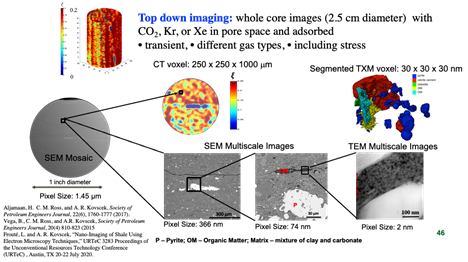Seal Effectiveness and Durability
Storage formations need to contain buoyant fluids such as hydrogen and/or carbon dioxide over substantial time scales of decades to centuries. Hence, the durability and permeability of the seal that prevents buoyant fluid migration out of the storage formation are significant issues to be assessed to improve storage security. Despite being widespread in the subsurface, understanding of the mechanics and chemical alteration of seals is not advanced. Predicting the response of geologic reservoirs and seals to injection and storage of nonaqueous fluids is critical to understanding their potential for long-term storage. The couplings between flow, chemical reactions, and stress/strain are highly complex in these multi-component, multi-scale systems and are specific to each formation type and subsurface application.
Imaging of seal material as fluids, such as carbon dioxide, penetrate the seal or as seal material is exposed to nonequilibrated aqueous fluids, such as acidified brine, is fundamental to our studies. We image shale seal material at core scale using x-ray computed tomography and at successively finer scales using scanning electron microscopy to view rock fabric and transmission electron tomography to visualize pores. We have pioneered top-down multiscale imaging workflows to probe details of flow, adsorption, and reaction across scales as illustrated in the figure below. We also image diffusion of fluids through impermeable rocks with variants of these methods.

Summary of a top-down imaging workflow. Images cascade in decreasing length scale from cm to 100’s of nm. Top left is an image of a shale core (2.5 by 5 cm) saturated with carbon dioxide. Hotter colors indicate more carbon dioxide. The core is subsequently sectioned and subvolumes extracted for imaging at successively greater resolution including nanoCT (TXM). On the bottom right is a transmission electron microscope image of kerogen between grains with nm-sized pores in the kerogen. Note the 100 nm scale bar.
Importantly, we are addressing the question of how and why rock permeability and mechanical properties evolve in space and time in the presence of different fluids and gases. The poroelastic response of a rock determines how injection impacts effective stress. Viscoelasticity/plasticity is the capacity of a rock to undergo time dependent deformation and support differential stress over geologic time. Nonaqueous fluids such as hydrogen and carbon dioxide may alter the mechanical and deformational properties of both reservoir rocks and seals through adsorption, dissolution/precipitation, or multiphase behavior. These effects and any potential couplings to flow at pore to reservoir scales are not well understood and need to be studied experimentally.
Also of primary interest is the behavior of fractures and faults with nonaqueous fluids. Fractures are complex, rough surfaces where stress is supported by a population of asperity contacts. The area and frictional resistance of these contacts determines under what conditions fractures can slip as faults. The presence of nonaqueous fluids may alter the distribution, area, or frictional strength of asperities, which may impact the susceptibility of a fracture to slip or close over time. Hence, we are measuring the friction coefficient of fractures in different fluid environments. Fault slip can damage seals and well casings while fracture closure can diminish injectivity and storage potential, so understanding the controls on fractures in each storage formation setting is critical to project success.